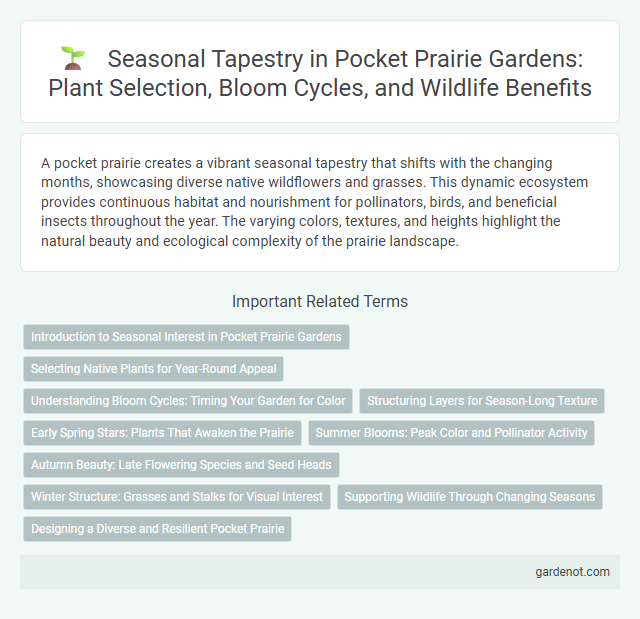A pocket prairie creates a vibrant seasonal tapestry that shifts with the changing months, showcasing diverse native wildflowers and grasses. This dynamic ecosystem provides continuous habitat and nourishment for pollinators, birds, and beneficial insects throughout the year. The varying colors, textures, and heights highlight the natural beauty and ecological complexity of the prairie landscape.
Introduction to Seasonal Interest in Pocket Prairie Gardens
Pocket prairie gardens showcase a vibrant seasonal tapestry through diverse native plant species that bloom and evolve throughout the year. These gardens enhance urban biodiversity by providing critical habitats and food sources for pollinators across spring, summer, fall, and winter. Careful selection of plants ensures continuous visual appeal and ecological benefits, making seasonal interest a fundamental aspect of pocket prairie design.
Selecting Native Plants for Year-Round Appeal
Selecting native plants for a pocket prairie ensures vibrant seasonal tapestry by providing continuous blooms, textures, and colors throughout the year. Emphasizing species like purple coneflower (Echinacea purpurea) for summer, switchgrass (Panicum virgatum) for fall structure, and goldenrod (Solidago spp.) for late-season color supports pollinators and maintains ecological balance. Integrating diverse native grasses and wildflowers enhances year-round visual interest while fostering habitat resilience and biodiversity.
Understanding Bloom Cycles: Timing Your Garden for Color
Pocket prairies showcase a seasonal tapestry by carefully understanding bloom cycles, ensuring continuous color and habitat throughout the year. Selecting native plants with staggered flowering periods maximizes visual appeal and supports pollinator activity from early spring to late fall. Timing your garden to align with these natural rhythms creates a dynamic, thriving ecosystem rich in biodiversity.
Structuring Layers for Season-Long Texture
A pocket prairie's seasonal tapestry thrives by structuring layers with diverse plant heights and textures, ensuring visual interest from early spring through late fall. Incorporating native grasses, perennials, and wildflowers with staggered bloom times creates continuous foliage and flower transitions that support pollinators year-round. This layered approach enhances soil health, moisture retention, and habitat complexity, promoting a resilient, season-long textured landscape.
Early Spring Stars: Plants That Awaken the Prairie
Early spring stars like Virginia bluebells, bloodroot, and trout lilies herald the prairie's awakening with vibrant blooms that provide crucial nectar for emerging pollinators. These native perennials thrive in well-drained soils, initiating the seasonal tapestry of color and life long before taller grasses dominate the landscape. Their early blooming cycle supports biodiversity by sustaining bees, butterflies, and other insects critical to prairie ecosystem health.
Summer Blooms: Peak Color and Pollinator Activity
Summer blooms in pocket prairies create a vibrant tapestry of peak colors, attracting a diverse array of pollinators such as bees, butterflies, and hummingbirds. Native wildflowers like coneflowers, black-eyed Susans, and bee balm reach full bloom, providing essential nectar and pollen resources. This seasonal peak supports ecosystem health by enhancing pollination rates and promoting biodiversity within small urban or suburban green spaces.
Autumn Beauty: Late Flowering Species and Seed Heads
Late flowering species such as asters, goldenrod, and Joe-Pye weed create a vibrant autumn tapestry in pocket prairies, attracting pollinators even as temperatures drop. The seed heads of native grasses like little bluestem and switchgrass provide essential food sources for birds while adding structural interest during late fall and winter months. This seasonal display not only enhances biodiversity but also supports wildlife through the colder seasons.
Winter Structure: Grasses and Stalks for Visual Interest
Winter structure in pocket prairies is enhanced by the visual interest of grasses and stalks that persist through the cold months. Species such as little bluestem, switchgrass, and prairie dropseed provide intricate textures and warm tones against the winter landscape. These elements support habitat diversity while maintaining aesthetic appeal during dormant seasons.
Supporting Wildlife Through Changing Seasons
Pocket prairies create a seasonal tapestry that supports diverse wildlife by providing continuous habitat and food sources throughout the year. Native grasses and wildflowers bloom in succession, ensuring pollinators like bees and butterflies have nectar from spring through fall, while seeds and shelter support birds and small mammals during winter. This dynamic ecosystem fosters biodiversity and resilience, making pocket prairies vital corridors for wildlife amid urban and suburban landscapes.
Designing a Diverse and Resilient Pocket Prairie
Designing a diverse and resilient pocket prairie involves selecting native grasses, wildflowers, and shrubs that bloom in succession throughout the seasons to create a vibrant seasonal tapestry. Incorporating species with varying root depths enhances soil health and water retention, while diverse plant structures provide habitats for pollinators and wildlife year-round. Strategic layering of plants ensures visual interest and ecological balance, fostering a self-sustaining mini-ecosystem in urban or small-scale environments.
Seasonal tapestry Infographic

 gardenot.com
gardenot.com